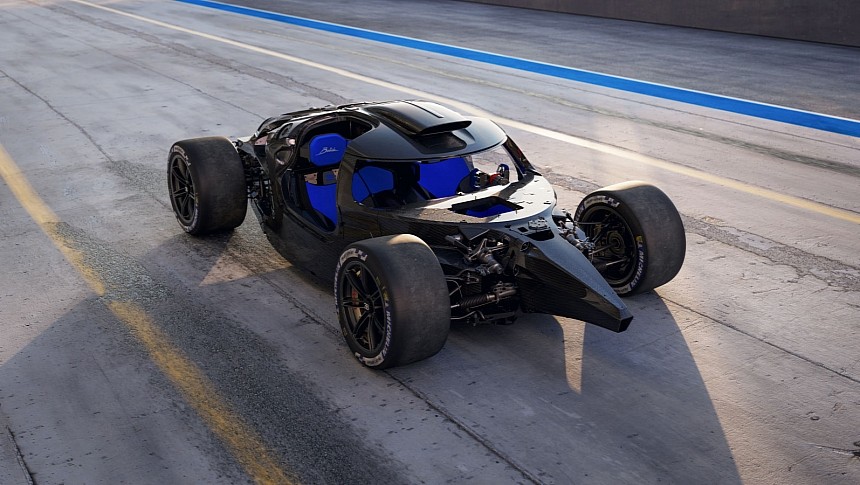The Bugatti Bolide arrived in 2020 as the last unicorn of the brand: the last Bugatti model to be powered by the mighty W16. Three years later, we get to see it bare naked, stripped down to the chassis, as never before, as the French automaker reveals all secrets in terms of safety.
'Bolide' is French for 'racing car.' And it does make sense, because this is a track-only hyper sports car with a monocoque compliant with the Federation International de l'Automobile LMH and LMDh stringent standards.
To be able to design this car and make it fit around the 8.0-liter W16 turbocharged engine, the monocoque is made of carbon fiber composites, which are normally used only in Formula 1 and Le Mans race cars.
The layout allows the powertrain to be mounted 60 millimeters further forward than in the Chiron, which enhances balance and stiffness. Now Bugatti reveals never-seen-before images of the Bolide stripped down to the chassis to reveal its secrets.
One of them is the manner in which it became safe enough for a track-only racing car. There was no room for compromise. For instance, rollover protection is paramount. The test involves a 7.5-ton load applied to the A-pillar of the car. If the deflection is more than 50 millimeters (1.96 inches) and cracks show up in the structure within 100 millimeters (3.94 inches) from the point of impact, the car fails the test. But there were no cracks in the Bolide at all.
The second rollover test involved a 12-ton load applied to the B-pillar, and a third brought a 6-ton longitudinal load applied to the monocoque, simulating rollover resulting in a rear impact with a barrier. The Bolide passed these tests as well.
The car is equipped with an automatic, military-grade fire extinguishing system.
Bugatti attached the wraparound headrests to the dihedral doors to make ingress and egress from the two-seat cockpit easier. They are designed in compliance with the GT3 regulations and joined to the door frame via an x-shaped bracket made from 3D-printed aluminum. It weighs around 300 grams (10.5 ounces) but is able to withstand a load of over 700 kilograms (1,543 pounds).
FIA-approved six-point harnesses keep the driver and co-driver firmly in place when extreme forces generated during cornering kick in or during acceleration and braking. The two of them sit in seats tested to the LMH regulations.
Traction control, electronic stability control, and anti-lock braking system keep the car stable at all times, regardless of the weather. The Bugatti Bolide wears high-performance Michelin Pilot Sport slicks.
The first customers are set to get delivery of their racing cars in 2024. That is when they will enjoy all the 1,578 horsepower (1,600 PS) and 1,180 lb-ft (1,600 Nm) of torque.
To be able to design this car and make it fit around the 8.0-liter W16 turbocharged engine, the monocoque is made of carbon fiber composites, which are normally used only in Formula 1 and Le Mans race cars.
The layout allows the powertrain to be mounted 60 millimeters further forward than in the Chiron, which enhances balance and stiffness. Now Bugatti reveals never-seen-before images of the Bolide stripped down to the chassis to reveal its secrets.
One of them is the manner in which it became safe enough for a track-only racing car. There was no room for compromise. For instance, rollover protection is paramount. The test involves a 7.5-ton load applied to the A-pillar of the car. If the deflection is more than 50 millimeters (1.96 inches) and cracks show up in the structure within 100 millimeters (3.94 inches) from the point of impact, the car fails the test. But there were no cracks in the Bolide at all.
The second rollover test involved a 12-ton load applied to the B-pillar, and a third brought a 6-ton longitudinal load applied to the monocoque, simulating rollover resulting in a rear impact with a barrier. The Bolide passed these tests as well.
The car is equipped with an automatic, military-grade fire extinguishing system.
Bugatti attached the wraparound headrests to the dihedral doors to make ingress and egress from the two-seat cockpit easier. They are designed in compliance with the GT3 regulations and joined to the door frame via an x-shaped bracket made from 3D-printed aluminum. It weighs around 300 grams (10.5 ounces) but is able to withstand a load of over 700 kilograms (1,543 pounds).
FIA-approved six-point harnesses keep the driver and co-driver firmly in place when extreme forces generated during cornering kick in or during acceleration and braking. The two of them sit in seats tested to the LMH regulations.
Traction control, electronic stability control, and anti-lock braking system keep the car stable at all times, regardless of the weather. The Bugatti Bolide wears high-performance Michelin Pilot Sport slicks.
The first customers are set to get delivery of their racing cars in 2024. That is when they will enjoy all the 1,578 horsepower (1,600 PS) and 1,180 lb-ft (1,600 Nm) of torque.











